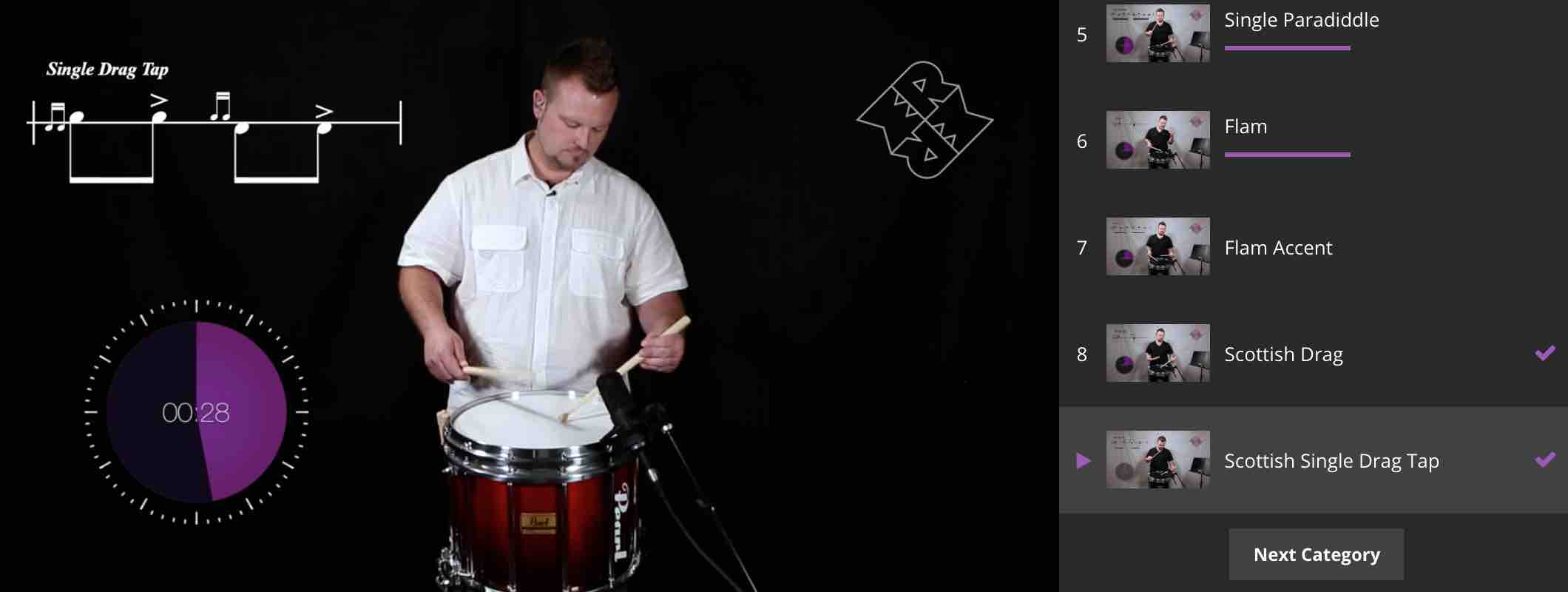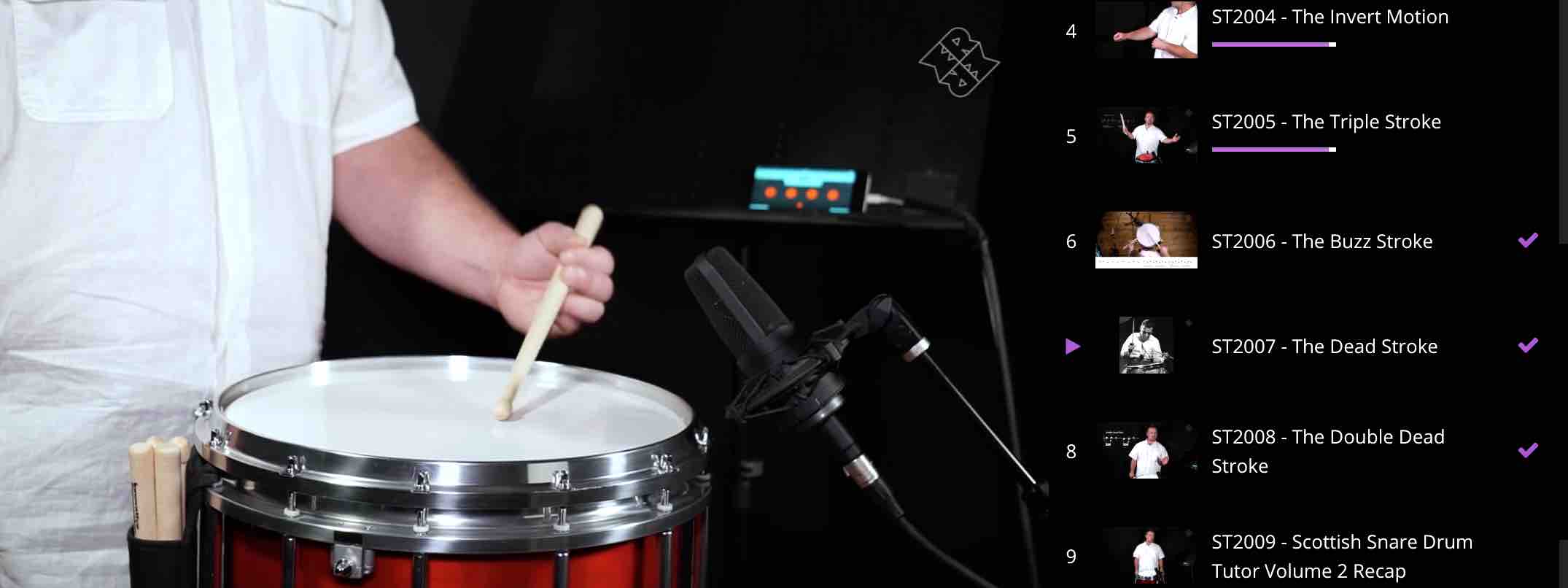

Dave's Blog | #3:
Still Drag'n it Out
Still Drag'n it Out
A Monster Blog Series by Dave Bullard
More fun with the Pipe Band Drag:
It’s important to resist the tendency to raise my arm and sort of ‘stab’ down onto the head at a sharper than normal angle. This cheats the gesture and in the long run will become a liability when it comes to fluidly dropping them into quicker patterns. Starting the motion flat and at grace note height helps keep it nice and delicate.

Plus, why stab when you can dip?
The Dip
You may have not have noticed the ‘dip’ before. It’s something that McWhirter and other Monsters do when they play a Drag.
The best way to isolate this motion is in the Open-Closed-Open classes on Rhythm Monster. They have most of the common Pipe Band rudiments broken-down, plus some American rudiments.
Check out this McWhirter left hand:

I love how he’s like “Allow me to present my fantastic drags." *slight bow*
His wrist straightens out and he just kind of places the stick onto the head.
That motion is the result of leading with the tip of the stick as opposed to the usual “whip’ motion from the wrist,
Leading with the tip this way allows him to make contact with the head and stop the momentum while his wrist continues its downward motion. This in turn allows his wrist/4th finger to rotate the tip of stick up after the touch, allowing for a Moller-esque ‘upstroke’ as he lifts his wrist. Notice how he leads the upstroke with the tip of the stick too.
It’s a subtle gesture, but for me it is a pretty important one. I have found it really helpful to drill this slowly and with exaggerated motions.
This rotation is not as easy to achieve with the right hand and I suspect that this is why there are relatively few instances of left hand lead Drags in the scores that I have worked on.
Check-out more McWhirter Awesomeness at StevenMcWhirter.com!
Width (length)
Getting the ‘width’ (or length of sound) from the Dead Stick just right is challenging when you’re playing at that speed. To work on that I’ve been playing them while changing the distance between the Drag and the Accent, starting in unison and fattening up through the Drag and full on into Dead Stroke territory as I go.
ST2007- The Dead Stroke, from Rhythm Monster's Snare Drum Tutor, goes over this beautifully. One of the exercises from the, "Dead Stroke & Double Dead Stroke Studies" sheet walks each hand through every variation in note length from Buzz Stroke to Dead Stroke, allowing each hand enough time to realize the difference in both sound and feel:
It’s slow
Compared to a 'normal' grace note from a Flam, the Drag is inherently limited speed wise. There’s just no way around the fact that the stick stops dead on the head and that there is a minimum amount of time that you need to get it going again. As tempting as it is to work them into a Triple Grid pattern (etc.), so far I’ve found that frustrating and possibly useless. I’m still new to the style, but I haven’t seen much like that in the literature, well not yet anyway ;)
You rarely see them played hand to hand either. At performance tempos, they are often at the front of a Double Stroke with the opposite hand, requiring the Double Dead Stroke to get into the Dead Stroke.
Reid Maxwell's, "The Pipe Band Drag" class covers this for both beginner and advanced figures.
Can't get access to some of the classes? Subscribe today and join Dave and thousands of other Monster Drummers from around the world by learning online with Rhythm Monster!
Gripy practice pads (might) hold you back (a bit)
If you practice on an Outlander or similar pad that is at all sticky, you run the risk of unconsciously relying on that friction to help you deaden the bounce. Try putting a piece of paper on top your pad while practicing it to see what I mean. And please remember...
It’s not a flam!

It’s not going to just slot right into all of your Flam rudiments. It will work well with some, not so well with others. The technique really is alien to DCI folks. None of your many tap-accent exercises will help even a little bit. I have had some success replacing the accent with a Dead Stroke tho. This helps me isolate the motion so that I can focus on the finer points.
It’s not a note either!
Well... not to me anyway.
I like to imagine that I’m muting the head with the stick rather than playing a dead grace note.
It helps me to think about touching the drum as lightly as possible and for just long enough to get the right tone out of it. And as we all know…sound always wins.
In the end it’s all about the sound.
At first the sound of the Drag was not obvious to me. After working on them so much and transcribing a few excerpts of solos, it’s hard to believe that I didn’t notice them right away. It’s such a chunky, satisfying sound.
I feel like it’s similar to playing a harmonic on a guitar.
If you play the Drag on a Drum Set tom-tom you might notice that it mutes the fundamental note of the drum. I’m not certain, but I swear that you get a little bit of that on the Pipe Snare too. I’m quite certain that there’s always a little bit of ‘fuzz’ in there also.
After I got a feel for playing them better,
I found that just focusing on producing
that sound is often all I need
to do to play them well.
Even so, every once in a while I’ll forget and start to choke the poor stick to death again and it starts to sound robotic, clunky and generally horrible. Keeping the Drag delicate while maintaining an even volume level on the surrounding notes is especially challenging for me and I tend to accent them by accident. Once again, focusing on the sound while relaxing my grip helps a lot.
To sum up
The tendency to think of the Drag as resisting the rebound of the head was leading me to death-grip the stick in an attempt to smother the bounce.
This was making the ‘recovery’ stroke much more difficult than it needs to be. It was also leading me to apply way to much energy to the gesture which was killing any flow and resulting in a choppy, hesitant sound. To combat this, I’ve been focusing on the sound while imagining that I’m gently lowering the bead of the stick onto the head.
Sort of like catching a falling egg right before it hits the ground.
Dragging Conclusions
I think this rudiment might be the toughest for DCI folks to come to terms with.
The similarity to Flams means that there is a lot of unlearning to be done. It’s tempting to apply old methods to new gestures, but that doesn’t work here.
Pretty much every exercise that I’ve ever played was focused on teaching me to recover and control the energy of the rebound in various ways...This is the opposite of that...
For the briefest moment, the stick is at rest and totally disconnected from the momentum that placed it there. Recovering from that break in the motion requires learning something totally new, and that’s what I love the most about this stuff.
To my hands and ears it’s brand spanking new, and that’s unbelievably exciting.
Having learned the basics so long ago, I’m not used to really paying such close attention to the mechanics of what I’m doing. But that’s what it takes. It takes breaking the gesture up into simpler chunks and methodically working your way through them, thinking all the while about every little motion that your hands make.
It makes me feel like a beginner and that can be frustrating, but it’s rewarding as well. I had forgotten what it was like back in 6th grade. I remember when it was just impossible for me to play the simplest accent patterns, let alone play an accent with my left hand!
But I also remember the drive to improve.
And that’s ultimately what I love about drumming. There are few things better than the feeling that you get when that impossible figure that you’ve been woodshedding begins to just flow from your hands. Trying to find new places to wedge fFams into was getting a bit old if I’m being honest and discovering Scottish Pipe band drumming has reinvigorated my drumming, challenging me in ways that I didn’t even know existed. It’s been a while since I’ve had the chance to have that experience. Turns out, I really missed it.
That feels like a pretty good start to this story.
Thanks for reading.
Next Up: What does this even mean?!

I’m going to tackle Buzz Roll notation and interpretation, Trizlets, and check patterns.
See you next time.
Hey, you made it to the end! Isn't it fun to read and learn? Since you're clearly into learning stuff, below is a super secret link for a 7-Day Free Trial to Rhythm Monster! That's right, friend, 7 days of blissful online drumming education accessible from any device, worldwide. Way to be awesome!
Why you still reading, pal? I thought you were into learning? Get click'n Friend!
🥁😈

Why Choose Us
Integer nisl odio, scelerisque
fermentum rutrum leo. Praesent sit amet sem aliquet, dapibus metus et, tempor sapien. Cras varius metus metus, ac tempor ex malesuada lacinia. Nulla facilisi. Integer ultrices, risus sed euismod rhoncus
orem leo egestas velit, id volutpat ex nibh a neque. Quisque orci metus
iaculis libero. Nam porttitor nisi sed elit dictum, sed rhoncus
ipsum luctus. Pellentesque viverra, diam ac euismod pharetra











